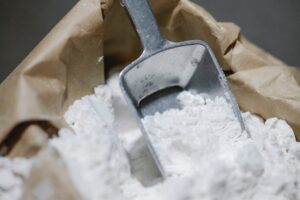When your dough forms a ball, it simply means that the gluten is forming well. Gluten is the protein responsible for the dough’s elasticity and ability to maintain its shape.

However, if your dough has trouble coming together into a ball, it means your flour isn’t high enough in protein. This happens occasionally, even to the best baker.
Sometimes the dough doesn’t form the required texture. This could be due to various reasons:
Why Your Dough Isn’t Forming a Ball and What to Do About It?
When you properly mix the dough, it ensures a consistent texture in baked goods. Whether it’s bread, pizza, or pastries. It also aids in gluten formation.
This is important in getting the right structure and elasticity in baked goods like bread. To ensure that your baking is even and it rises properly. If your dough isn’t forming a ball in the mixer, here’s why and what you can do:
The Dough is not Sufficiently Hydrated
This means that there are not enough liquid ingredients in your mixture to balance out the dry ingredients. When there’s not enough liquid in it, the dough may remain dry, and crumbly.
This can make it difficult to form a ball or come together properly. When the flour hasn’t absorbed enough liquid it hinders proper gluten development. This is why it might be challenging for the dough to come together.
What To Do:
- Try adding a small amount of extra liquid. It could be water, milk, or other liquids specified in the recipe. Do this gradually until the dough reaches the desired consistency. Include the liquid while the mixer is running. This helps the flour absorb moisture evenly, allowing the gluten to develop properly.
- Be careful not to over-hydrate or add too much liquid. This can make the dough sticky.
- Stop the mixer occasionally to scrape down the sides of the mixer’s bowl. This is to ensure that all the dry ingredients are properly mixed with the liquids. Then you can resume mixing.
- Sometimes you might allow the dough to rest for 10-15 minutes. This can help the flour fully absorb the liquid and allow the dough to form properly.
Using the Wrong Type of Flour

This is the most common reason why your dough isn’t forming a ball. The type and quality of flour you use also significantly affect the dough consistency.
This is primarily due to differences in protein content, texture, and gluten formation. There are typically three types of flour. All-purpose, Bread flour and Pastry flour.
All-purpose flour for instance is a balanced flour suitable for various baking needs. However, it may not provide enough gluten for bread.
Normal bread flour has a higher protein content that promotes better gluten formation, using low-protein flour like pastry flour for bread might lead to weak gluten development.
This would no doubt affect the dough’s structure and how it rises. Pastry flour has a lower protein content and thus would give you a more delicate, tender texture.
This is perhaps suitable for pastries and some cakes but may not yield a well-risen bread.
What To Do:
- If a particular type of flour isn’t available, always substitute within reason. What some bakers do is to blend different flours to achieve a similar protein content. For example, mixing all-purpose flour with a bit of vital wheat gluten can mimic bread flour.
- Don’t forget to adjust other ingredients to suit the recipe, especially liquids. This is to compensate for differences in flour absorption rates.
Over-Mixing or Under-Mixing
Both can have substantial impacts on the texture, and gluten development of your dough. Mixing dough for too long or too short a time can affect its elasticity.
You overmix when you knead the dough excessively, longer than the required timeframe. This leads to the breakdown of gluten strands and you’re left with an overly elastic, tough, or dense dough.
You could also be undermixing when the dough hasn’t been kneaded enough. It is important to find the right balance between overmixing and undermixing. However, this would take practice and occasional adjustments.
What to Do:
- There’s an appropriate timeframe for kneading your dough, depending on what kind of pastry you’re making. Follow the recipe’s instructions for mixing times. Over-mixing can develop too much gluten, making the dough tough, while under-mixing might result in a lack of structure. If there’s no specified time, just aim for a smooth, elastic consistency.
- Immediately you notice the dough becoming too elastic, stop mixing. Consider adding water or milk in small amounts to soften the dough. If possible, you could use flour gradually to balance out the texture.
- If the issue is undermixing, you need to continue kneading the dough for a longer period. This would encourage gluten development.
- Allow the dough to rest and ferment for a longer period. This would also help the gluten to develop naturally.
Using the Incorrect Ingredients or Incorrect Measurements

Using the incorrect ratio of ingredients can also significantly affect the texture, and consistency of your dough. So, when your dough fails to form a cohesive ball, your recipe could have gone wrong somewhere.
The proportion of flour, water, yeast, salt, or other ingredient might not be accurate according to the recipe. When this happens, it is difficult to achieve the desired outcome.
Also, if there’s too much flour compared to the liquid ingredients, the dough can come out dry, and stiff. On the other hand, too much moisture can result in a sticky, wet dough.
Also, incorrect amounts of yeast or salt can affect the fermentation and affect how the dough rises.
What to Do:
- Ensure you’re using the correct type of flour and accurate measurements as specified in the recipe. Even slight variations can affect dough consistency.
- Refer to the recipe you’re following again and again. Ensure accurate measurements of all ingredients.
- Always use a kitchen scale or measurement for precision. Adjusting the ratios gradually, especially when adding liquids or flour, can help in achieving the correct consistency and texture for the dough.
Your Mixer Might be the Problem
If your dough still won’t form properly, it’s time to think about the likelihood that your mixer is the problem. A mixer that’s faulty or not working properly would interfere with the dough-making process.
It might even result in uneven mixing, leaving parts of the dough improperly combined.
What to Do:
- Inspect the mixer for signs of malfunction. It could be issues with the motor which can cause overheating or stalling during the mixing process,
- Check out the mixer’s speed settings. If the mixer’s speed settings aren’t working correctly, it can lead to inconsistent mixing,
- Knead by hand. Sometimes, the dough is close to forming a ball but it is not quite there yet. In this case, you might need to finish kneading it by hand on a lightly floured surface. This allows you to adjust the texture by adding a little flour or water as needed. Do this until you achieve the consistency you’re looking for.
Finally
We’ve discussed a few typical causes for your dough not to be shaping into a ball in the mixer. Hopefully, these suggestions will prove useful to you.
It can be frustrating to not achieve the right consistency with your baking, especially as a new baker. However, remember that baking is a continuous learning process. It’s acceptable to run across some roadblocks.
Even if your first few doughs do not come out perfectly, don’t give up.
